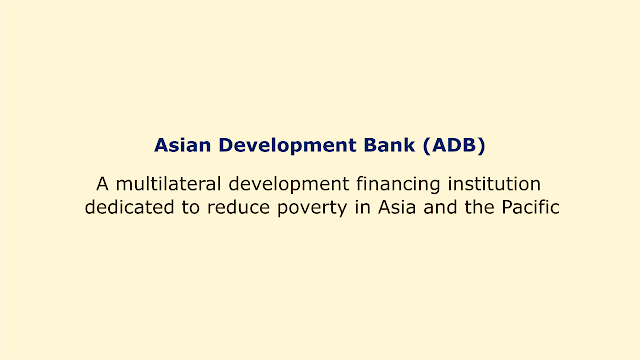 |
| Image: Moneybestpal.com |
The Asian Development Bank (ADB) is a global agency that provides development funding with the goal of eradicating poverty in Asia and the Pacific. By offering financing and technical help for various development efforts, ADB attempts to raise the quality of people's lives.
ADB was founded in 1966 and has 68 members, 49 of whom are from the area. ADB has 31 field offices and four representative offices worldwide in addition to its headquarters in Manila, Philippines. Masatsugu Asakawa, who took over as ADB president in January 2020, is in charge.
Policy dialogue, loans, equity investments, grants, guarantees, technical support, and co-financing are the major tools used by ADB to aid its developing member countries. ADB also raises money from commercial sources and offers bonds on global capital markets. ADB provided $31.6 billion in financial resources in 2020 to aid in its members' response to the COVID-19 epidemic and recovery activities.
ADB's operations are governed by its long-term vision of an Asia and the Pacific region that is wealthy, inclusive, resilient, and sustainable while continuing its fight against extreme poverty. Seven operational priorities identified by ADB's Strategy 2030 are in line with the Paris Climate Agreement and the Sustainable Development Goals. Making cities more livable; advancing rural development and food security; reducing remaining poverty and inequalities; quickening the progress of gender equality; combating climate change; building climate and disaster resilience; enhancing environmental sustainability; strengthening governance and institutional capacity; and fostering regional cooperation and integration.
Agriculture and food security, climate change, digital technology, education, energy, the environment, the financial sector, fragility and vulnerability, gender equality, governance, health, public-private partnerships (PPP), regional cooperation, social development, transport, urban development, and water are just a few of the areas where ADB supports projects. Some examples of ADB's flagship projects are:
- The Greater Mekong Sub-region (GMS) Program includes Cambodia, the People's Republic of China (more specifically, Yunnan Province and Guangxi Zhuang Autonomous Region), the Lao People's Democratic Republic (Lao PDR), Myanmar, Thailand, and Viet Nam. With better connectivity and infrastructural development, the program seeks to improve economic ties between the nations. The program has sponsored more than 400 projects totaling more than $23 billion since its start in 1992.
- The Central Asia Regional Economic Cooperation (CAREC) Program includes Afghanistan, Azerbaijan, Georgia, Kazakhstan, Kyrgyz Republic, Mongolia, Pakistan, Tajikistan, Turkmenistan, and Uzbekistan. The program focuses on four major areas: transportation, trade facilitation, energy, and the creation of economic corridors. The program has sponsored more than 200 projects totaling over $39 billion since its start in 2001.
- The South Asia Sub-regional Economic Cooperation (SASEC) Program includes Bangladesh, Bhutan, India (particularly the state of Bihar), the Maldives, Nepal, and Sri Lanka. With better cross-border connectivity, increased commerce among member nations, higher energy security, and strengthened regional institutions, the initiative seeks to advance regional prosperity. The program has sponsored more than 60 projects totaling over $13 billion since its start in 2001.
In order to offer its members and stakeholders knowledge products and evidence-based policy guidance, ADB also conducts economic research and analysis. Several studies and publications are released by ADB on a variety of subjects, including economic projections, development indicators, taxation, gender equality, climate change, and digital technologies. To disseminate information and viewpoints on regional development challenges, ADB also runs online hubs such as the Asia Pacific Tax Hub, Development Asia magazine, ADB Blogs, and ADB Data Library.
In conclusion, the Asian Development Bank is an important ally in the region's development. It offers both financial and technical support to help its members' initiatives for inclusive and sustainable growth and poverty reduction succeed. In order to handle shared issues and opportunities, it also promotes regional cooperation and integration. In order to inform and have an impact on policies and practices, it also creates and disseminates information and innovation.
